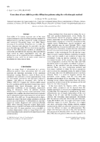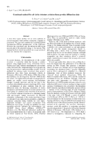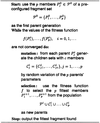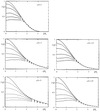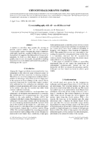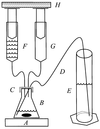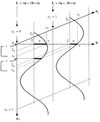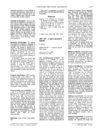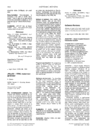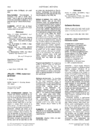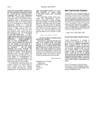issue contents
October 1999 issue

Cover illustration: Simulated diffraction pattern for a two-dimensionally disordered decasil (porous SiO2) calculated using a fast recursive algorithm. The plane is perpendicular to c with the reciprocal index l = 1; the error probability is 0.5 and the intensities are scaled to 25% of the highest value. Courtesy of Peter Daniels.
research papers
A method of quantitative texture analysis of small domains of material is presented and illustrated with examples from metal wires, polymer fibres and bone material.
An equation is derived to calculate the 2θ zero shift in powder diffraction patterns based on the reflection-pair method. The equation can be used before indexing to diagnose and correct the 2θ zero shift.
Energy-dispersive anomalous X-ray scattering has been used to determine the polarity of an epitaxially grown (Ga,In)P layer on a (001) GaAs substrate as an example to show the applicability of this method as a routine procedure for non-centrosymmetric thin-film systems.
The superlattice features giving localized destructive interference in X-ray specular reflectivity are analysed with a simple kinematical model. This effect can be used to obtain energy filters at fixed incidence angle.
A new direct-space method for ab initio solution of crystal structures from powder diffraction data by combined global optimization of pattern difference and potential energy is described.
Attenuation of the X-ray wavefield in GaAs and Si under Bragg surface diffraction and the existence of effective satellite peaks in multiple quantum wells are described.
When a neutron imaging plate is used as detector, the gamma-ray background cannot be ignored. The effects of gamma rays on a neutron imaging plate and how to shield the imaging plate are reported.
The general scheme of X-ray stress analysis on cylindrical surfaces is simplified for many practical cases. This can be used to validate experimental conditions and apply corrections to take into account the effect of geometry.
The small-angle scattering intensities of cylindrical and spherical lamellar grains are analytically determined.
Evolution strategies have been applied to explain the electron densities of orientationally and conformationally disordered structures and to refine disordered fragments. In connection with concepts from qualitative physics, the strategies were used to compute reorientation pathways and to model high-pressure behaviour in a virtual experiment.
Calculations of the radial distribution function in a diffraction experiment by Fourier transform and by a maximum-entropy algorithm give similar results on data with little error margin. In this case the Fourier transform is numerically more robust than the maximum-entropy method.
Monte Carlo simulations are used to calculate the small-angle scattering, the nonideal part of the chemical potential and the compressibility factor for ellipsoids of revolution of varying concentrations and eccentricities. Comparisons are also made with results obtained from the literature.
Combined application of optical microscopy, goniometry, synchrotron X-ray microradiography, diffraction and topography identifies and spatially localizes imperfectly crystalline twinned regions in columnar growths in which the core volume is substantially unstrained and free of lattice defects.
Refinements of known structures using different weighting schemes produce differing results.
A new procedure for angle calculations based on the intersections of conic surfaces is presented. It is applied to a six-circle κ diffractometer.
The microdiffraction from a single translation domain boundary (TDB) in β-Ni3Nb was recorded using a Hitachi HF-2000 FEG TEM microscope. The diffraction splitting effect of a TDB is well explained by the kinematics and dynamics calculations.
Simple derivations for infinite-slit-height-smeared SAXS from porous surface and mass fractals are presented, including an approximation for aggregated mass fractals.
Prior information on a structural fragment is used to improve the efficiency of the powder-pattern decomposition.
An X-ray diffraction study of two hydrated kaolinites, characterized by 10 and 8.4 Å basal distances, is reported. The study is based on a comparison between the experimental and calculated profiles.
Ultrafast atomic disordering in Langmuir–Blodgett (LB) films and TlAP crystals has been investigated by femtosecond time-resolved X-ray diffraction experiments using intense laser pulses.
Effect of sample transparency in powder diffractometry with Bragg–Brentano geometry as a convolution
Mathematical formulae for the effect of sample transparency in powder diffractometry with Bragg–Brentano geometry are examined. The overall profile function given by triple convolution of the pseudo-Voigt function with the horizontal divergence, sample transparency and vertical divergence aberration functions reproduces the experimental peak profiles well.
In the dislocation model of strain anisotropy, the contrast factors of dislocations play the most important role. In texture-free cubic polycrystals or powders, the contrast factors are a function of two parameters only, which are compiled for a wide range of elastic constants.
cryocrystallography papers
A method is described that permits the cooling of protein crystals with paraffin oil instead of conventional cryoprotective agents.
short communications
Simple methods for the preparation of organic solvent density gradients and the transfer of protein crystals into these gradients are described.
X-ray diffraction measurements of the trigonal phase of ZrMo2O8 from 80 to 925 K reveal highly anisotropic thermal expansion behaviour.
computer programs
A program for Microsoft Windows™ 95/98 is described that allows the use of a Gilson 222 autosampler (Gilson Inc., Wisconsin, USA) to set up many crystallization trials automatically.
The program MIMS (measuring incommensurate modulated structures) has been written for the determination of structural parameters of incommensurate one-dimensionally modulated structures by automatic search on four-dimensional Fourier maps.
laboratory notes
A method of mounting sample crystals in high-pressure diamond-anvil cells, aimed at facilitating the procedure of preparation of gaskets, and a simple spark eroder for laboratory use are described.
Compact split-plate ionization chambers are described for the alignment in two orthogonal planes of microfocus X-ray tubes to X-ray diffractometers or goniometers.
computer program abstracts
MSG provides a simple Web-based input form as an interface to the Molscript program for rendering the structures of biological macromolecules in Protein Data Bank (PDB) format. Output consists of a VRML rendition of the molecule viewable in a web browser.
A software package for visualizing various crystallographic aspects is presented.
A Java program for rendering electron-density data as VRML isosurfaces is presented.
software reviews
Free 

DIAMOND, reviewed by W. T. Pennington.
book reviews
Free 



 journal menu
journal menu










